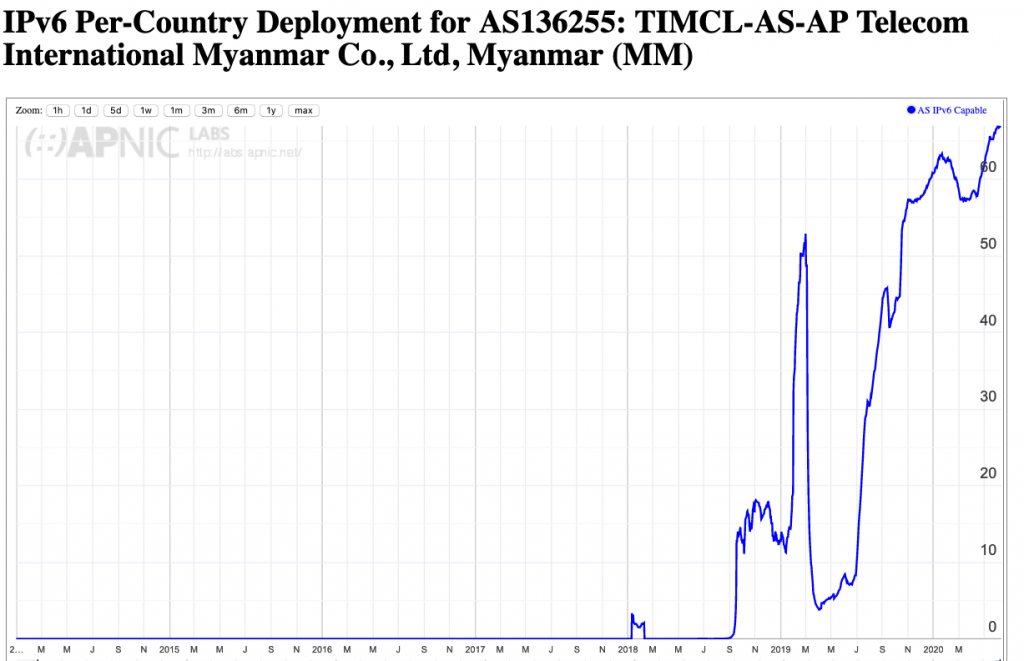
Myanmar’s Internet sector has boomed over the last decade—in 2010 less than 1% of the population was using the Internet, and now it’s closer to a third.
The economy’s relatively late entry to the global Internet community and the impacts of IPv4 exhaustion are making IPv6 an attractive option.
As of the start of June 2020, Myanmar was almost 14% IPv6 capable thanks to the efforts of Telecom International Myanmar Co. Ltd (Mytel). As Myanmar’s second largest and fastest growing ISP, it has over 10 million mobile subscribers using IPv6, and 100,000 on IPv6 fixed broadband.
Figure 1 – IPv6 deployment in Myanmar
Mytel Project Manager, Tran Dinh Nguyen, explains that IPv6 was a logical option, based primarily on price and availability. “Because there weren’t enough IPv4 addresses available, our CEO, Nguyen Thanh Nam, decided we had to deploy IPv6 right from the beginning.”
It has been a challenging but rewarding journey for Dinh Nguyen and the company, which only officially launched in 2018.
In the two years from first discussions in 2017 to the actual launch in 2019, Mytel planned, designed and made early steps toward implementing the rollout. A dual-stack solution was also needed to cater for those not ready to make the shift.
Staff also needed on-the-job training. “Our engineers were not familiar with IPv6 — the IT team actually set up the core network infrastructure that was only IPv4 capable in the beginning because that’s all they had done previously,” explains Dinh Nguyen.
“We didn’t know how to test its functions either and we weren’t sure if the issues we were seeing were due to our configuration in the core or customer premise equipment.”
Through trial and error, Dinh Nguyen says they realized one of the major problems was that the DNS didn’t support IPv6. “We had to resort to using Google’s Open DNS while we upgraded our six-month old DNS to one that was IPv6 capable.”
Mytel resolved further functionality problems through user experience testing, looking at the IPv4 customers versus the IPv6 customers. Availability, latency and speed were tested for a variety of activities, from web browsing to games, social media, uploading and downloading.
“We decided to begin with a small group of customers before expanding to include a larger group because we wanted to ensure we were taking care of our customers before launching the full IPv6 service,” says Dinh Nguyen. For IPv6 broadband, they started with a pool of 100 customers, before broadening it to 1,000 then opening up further.

In addition to internal workshops, Mytel encouraged engineers to practice in the lab and received pointers from their parent company, Viet Nam’s largest telco, Viettel, which began deploying IPv6 in 2017, as well as vendors. Viettel’s IPv6 capability is now well above 50%.
“For our fixed broadband service, we needed support from vendors to apply IPv6 to customer modems,” says Dinh Nguyen. “Some applications wouldn’t run when we used IPv6, and some handsets could support IPv6, but they weren’t stable. This meant we needed to contact handset vendors to fix these problems. This took up a lot of time.”
Xiaomi handsets required additional attention to work via IPv6, and certain games had issues that were gradually resolved.
Aside from these teething issues, Dinh Nguyen recognizes the benefits of deploying IPv6, besides the increased availability of IP addresses. “IPv6 reduces the size of the routing table and makes routing more efficient and hierarchical. Customers can reach IPv6 destinations without (Network Address Translation) NATs. This reduced the pressure on our Carrier Grade NAT system.”
He is anticipating further challenges, particularly regarding the ongoing demand for IPv4. “We expect to keep getting requests for IPv4, but that resource may not be available,” he says.
Mytel is not intending to move to an IPv6-only network but said that in a few years they would consider it, if all applications support IPv6.

The views expressed by the authors of this blog are their own and do not necessarily reflect the views of APNIC. Please note a Code of Conduct applies to this blog.


Cool!
Congrats!